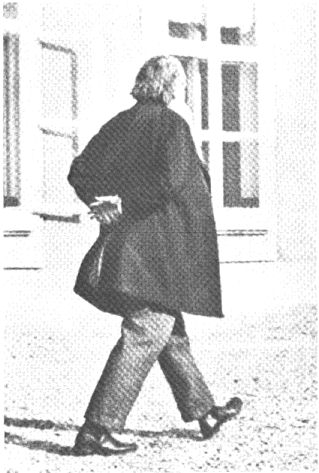
Johannes Brahms came from North Germany to Vienna at the age of
30 and since then the imperial city was his „principal domicile". He described
once what kept him here:
„... for instance the good pubs... and in Vienna you can easily
keep unmarried, in a small town an old bachelor is a caricature." In Vienna,
Brahms was esteemed and admired and he had numerous friends here, who were
of great importance in his life.
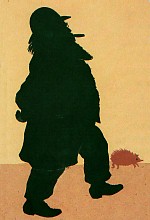
Brahms on the way to the „Roter Igel",
his favorite pub in Vienna
silhouette by Otto Böhler
Origin and childhood
Johannes Brahms was born on May 7th 1833 in Hamburg. The ancestors
on his father's side were farmers and craftsmen. His father Johann Jakob
Brahms (1806-1872) earned his living first as dance musician, later
he had an engagement as contrabassist at the Philharmonic orchestra. In
1830, he married Johanna Henrica Christiane Nissen (1789-1865),
his senior by 17 years. Johannes was the second child of the couple. Wilhelmine
Elisabeth Louise (called Elise) was born in 1831 and the younger
brother Friedrich (1835-1885) followed in 1835. All three of the
children were talented for music, but Johannes grew into a pianistic infant
prodigy. At the age of ten, he performed for the first time publicly, with
fourteen, he gave his first own concert (September 21st 1847). In the following
years he endeavored to make himself a name as pianist in Hamburg.
First journeys, acquaintance with Schumann
(1852-1857)
In 1852, Brahms made his first great concert tour with the Hungarian
violinist Eduard Hoffmann, called Reményi (1828-1898). In
Hanover, he met the court conductor and famous violinist Joseph Joachim,
who became a faithful friend to him. With a letter of recommendation of
Joachim, Brahms traveled with Reményi to Weimar to make a good first
impression on Franz Liszt.
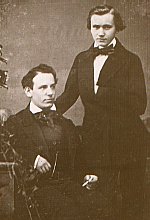
Brahms and Reményi (1853)
After a sojourn of several weeks, he left Weimar and parted also from
Reményi for serious artistic disagreements. On Joachim's advice,
Brahms went to see Robert and Clara Schumann in Düsseldorf in September
1853. This meeting was decisive for his artistic career: Schumann published
an enthusiastic article about Brahms in the „Neue Zeitschrift für
Musik" and helped him to win a publishing house's (Breitkopf &
Härtel) support for his works.
s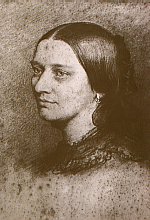
Clara Schumann
As Schumann was taken to a mental hospital after a suicide attempt in
1854,
Brahms moved to Düsseldorf to lend Clara Schumann assistance. His
reverence to her grew into a passionate love. Brahms stayed with her over
two years. During this time, he composed among others the 1st piano trio
in H major, the variations for piano F-sharp minor op 9 (about a theme
by Robert Schumann) and the ballads op 10.
At the Niederrheinischen music festival in 1855, he made
friends with the famous music critic Eduard Hanslick (1825-1904) and the
singer Julius Stockhausen (1826-1906) celebrated all over Europe.
After Robert Schumann's death in July 1856, Brahms left
the joint apartment in Düsseldorf to get more away from Clara Schumann.
Between Detmold, Hanover and Hamburg (1857-1862)
The next years were marked by the professional orientation. Three North
German cities determined first his sphere of activity: Detmold, Hanover
and Hamburg. In Detmold, he gave private piano lessons. During the winter
seasons 1857-59, the daughter of the reigning prince belonged also
to his students. He came to Hanover through the friendship with Joseph
Joachim. Here for instance, the piano concerto in D minor was performed
for the first time Joachim conducting accompanied by the composer.
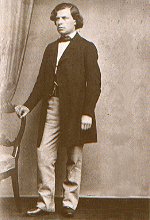
Joseph Joachim
In Hamburg, Brahms founded a small women's choir, for which he composed
the first two pieces of the three sacred choruses op 37, the Marienlieder
op 22 and the 13th psalm op 27.
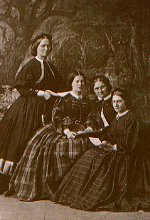
The Hamburger Frauenquartett
(women's quartet of Hamburg)
At that time, he met Bertha Porubszky, a Viennese woman who took
singing lessons in Hamburg and made music with him. Even after her return
to Vienna, Brahms did not break the contact with her. In 1861, Brahms
moved into an apartment Hamburg suburb Hamm. He composed here among others
the variations and fugue about a Händel's theme op 24 and the piano
quartet in G minor op 25 and A major op 26.
The first Viennese years
(1862-1871)
The uncertain existence of a freelance artist did not satisfy Brahms,
he aimed at a permanent engagement as conductor of the Hamburg philharmonic
orchestra. To ameliorate his chances, he wanted to make himself a name
also outside his native country and went in September 1862 for the first
time to Vienna, the musically most important metropolis of Europe at that
time. The singer Bertha Porubszky, who was acquainted with Brahms
since Hamburg, introduced him into the artistic circles here. Through her,
he got to know the pianist Julius Epstein (1832-1926) and the famous
Hellmesberger-Quartett. With this quartet he made his Viennese debut: On
November 16th 1862, he played the piano part of his piano quartet in G
minor op 25 in a concert of the Hellmesberger-Quartett. The Viennese public
received the young North German pianist with interest and benevolence.
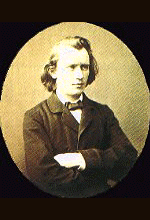
Johannes Brahms
Altough Brahms achieved the hoped-for success, the post of conductor
of the Hamburger Philharmonie was offered not to him, but to Julius Stockhausen.
He was deeply hurt by that. But in September 1863, they offered him the
direction of the „Wiener Singakademie" founded in 1858.
After a promising beginning, his cooperation with the choir became
more and more problematic. With his programming, where serious and gloomy
themes were predominant, he overtaxed the public as well as the singers.
He wanted to develop especially old choral music and rarely performed works
of Schumann, Mendelssohn and Beethoven and often the choir did not feel
up to this pieces. The keen competition of the „Singverein der Gesellschaft
der Musikfreunde" (choral society of the society of music lovers) soured
also his work with the Singakademie. Therefore, Brahms was soon tired of
his engagement and handed over the direction of the Singakademie in spite
of his unanimous re-election in June 1864.
Now, he was professionally independent again and in a position
to lead a „free artistic life". „Summer holidays" in popular spas and more
and more longer concert tours alternated with sojourns in Vienna. He earned
his living out of publishing fees for his works and the proceeds of his
concerts.
Brahms's concert tours
In the middle of the 19th century, travelling virtuosi had to fight various
difficulties. Usually, they travelled from one city to another and tried
to get a appearance at a more or less appropriate hall to perform their
art in front a public called together in haste. In most cases, the programs
presented works of great composer as well as local stars in varied order,
the pieces were specified rather inaccurately on the programs.
The part of piano virtuoso did not fit Brahms, who had to make
his living out of loud self-promotion. He regarded his concert tours as
a necessary evil: First of all, they helped him in money-making. Later,
Brahms considered them as a possibility to make his compositions known
by a large public and he travelled more and more often as conductor than
as piano virtuoso. Brahms' first tour, he made with the violinist Hoffmann
(Reményi) as his piano accompanier, was broken off after the visit
to Liszt in Weimar. In the next years, he made only shorter concert
tours in Germany, usually together with Clara Schumann.

Johannes Brahms and Julius Stockhausen (Vienna 1869)
In the sixties, he played in many concerts with his friends Joseph
Joachim and Julius Stockhausen. Aside from own compositions
he played works by Bach, Beethoven,
Schubert and Schumann.
He
made his last large concert tours from 1865 to 1868, later,
he came out publicly just as interpreter of his own works. Except Hungary,
his tours were limited to the German speaking area, Denmark and Holland.
As he was proposed for the honorary doctor by the University of Cambridge,
he preferred renouncing this honor to underake a journey to England. After
1872,
the concert tours were an integral part of his plans for one year. From
the mid-sixties on, he gained his living almost exclusively out of his
earnings from this tours.
The „Deutsche Requiem" (German Requiem)
In February 1865, Brahms received news that his mother deceased.
A few weeks later, he sent Clara Schumann a „choral piece... from a sort
of German requiem", the original version of the later fourth movement „Wie
lieblich sind deine Wohnungen". At the end of April, the first and
the second movement were also finished. Brahms used for his requiem some
drafts that he composed shortly after the death of his friend Robert Schumann
in 1847, but he never uttered that the bereavement of these two
dear persons prompted him to compose this work. He worked on the completion
of the score in Zurich and Baden-Baden during the summer months 1866.
In spring 1868, he added a new, fifth movement of the final version
to the requiem, which was already performed for the first time in Vienna
(December 1867) and Bremen (April 1868).
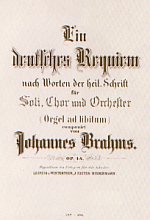
Cover of the first edition
Brahms, who felt an obligation to the musical tradition all his life,
composed in formal respect something new with the German requiem: He did
not set for instance the German rendition of the Latin mass for the dead
to music, but he produced himself a text copy for his composition from
select verses of the Holy Scriptures. The personal way of approach of the
composer to his task appears in the choice of the text: In this regard,
the German requiem is the tradition of the German Protestant church music
with its cantatas and Passions and with the musical exequies of Heinrich
Schütz. Musical factors are also connected with the great Protestant
church music of the 17th and 18th century, for instance the monumental
choral fugues or the inner counterpoint movements of the voices hidden
in homophonic structures and often scarcely audible. The powerful organ
point passages trace back to Bach's model.
The cycle keeps together through the homogenous keynote of the
select texts, the message of the first choral movement (consolation) forms
virtually the résumé of the main contents of the following
movements: patience - hope - joy - sorrow - confidence - deliverance.
On the top of the career
Brahms' connections with North Germany and his native town Hamburg relaxed
in the course of time. His mother died in 1865, his father in 1872.
In the meantime, he had also lost hope to get an appropriate position in
Hamburg. Vienna became really his home.
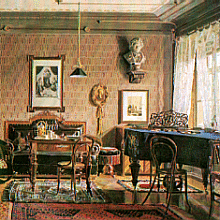
The music room in the Brahms' apartment
in the Karlsgasse
After different subtenancies in the first and second district, he moved
at the end of 1871 into an apartment at the Karlsgasse No. 4 next
to the Karlsplatz (the house does not exist anymore), where he lived till
he died. Due to the nearby new Musikverein building, the situation of the
apartment was very favorable to him, because he spent much time studying
old music at the archives of the Gesellschaft der Musikfreunde (society
of music lovers). He was on friendly terms with the archivist Eusebius
Mandyczewski.
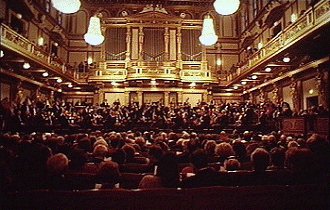
Musikverein
In 1872, The „Musikverein" offered him the artistic direction
of the society's concerts. As the Gesellschaft der Musikfreunde agreed
to comply with all conditions made by Brahms and to grant him the considerable
annual salary of 3000 guldens, he accepted the task. He carried out immediately
several reforms. He replaced the amateurs of the orchestra by members of
the excellent court opera orchestra and raised the number of rehearsals
for the choir. He programmed mainly older music and performed Bach, Händel
and Mozart. His own works were not so often on the program: Only
the Triumphlied, the rhapsody, the Schicksalslied and the German requiem
were performed during his triennial occupation as artistic director of
the Gesellschaft der Musikfreunde. After three successful seasons, Brahms
retired from the artistic direction of the society's concerts. He continue
to be on friendly terms with the Gesellschaft der Musikfreunde and Brahms
left the archives his very precious library.
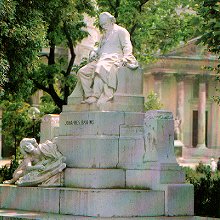
The Brahms monument at the Karlsplatz
The summer stays
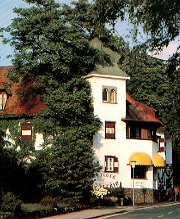
Leonstein castle in Pörtschach
on Wörthersee
All his life, Bramhs was fond of the outdoor life. During the winter
months, he went often for a long walk with friends in the outskirts of
Vienna. Since the sixties, he spent the summer months generally in the
country. During the first years after his move to Vienna, he was often
Clara Schumann's guest in German Lichtenthal near Baden-Baden. From 1877
on, he stayed usually also in summer in Austria, for instance in Preßbaum
near Vienna (1881), Pörtschach on Wörthersee (1877-1879),
Mürzzuschlag
(1884, 1885) and Bad Ischl (1880, 1882, 1889-1894, 1896). Generally
he left Vienna shortly after his birthday on May 7th and returned only
at the beginning of October. All these towns were fashionable bathing and
health resorts, where the „high" society of Vienna met every summer. Particularly
Bad Ischl was reputed to be an exclusive holiday resort, since it was the
yearly summer residence of Emperor Franz Joseph I. Also Johann
Strauss, a friend of Brahms who had a high opinion of his music, stayed
here in Summer. Brahms spent ten summer in all in Bad Ischl.
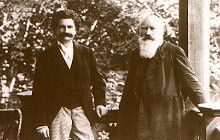
Johannes Brahms and Johann Strauß in Bad Ischl
The summer stays meant a particular creative time to Brahms. He gave
there its final form to many compositions, which he had carried around
with him half-finished in his head or on drafts. He used to complete his
works in his head strolling, until he reached a stage, where he had just
to write them down with utmost concentration. The first half of the day
was devoted to the work, in the evening he found relaxation in the circle
of friends.
|